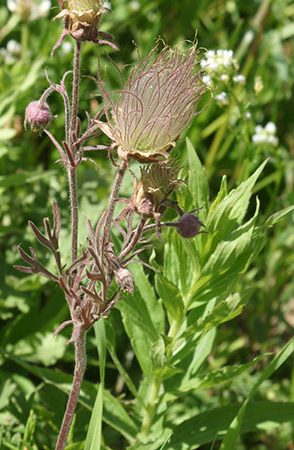Geum triflorum / prairie smoke
- among the earliest bloomers in the spring
- clusters of nodding reddish, pink, maroon or purple flowers
- flowers in groups of 3
- distinctive fruit – like silvery-pink or mauve “troll dolls”
- in large populations, fruiting plants look (sort of) like smoke
Also known as: old man’s whiskers, purple (or red) avens, long-plumed avens, three-flowered avens
Prairie smoke is among the earliest bloomers in the spring. The inflorescences are clusters of nodding reddish-pink, maroon or purple flowers on 12-18” stems. While there may be up to 9 flowers on each stem, they generally occur in groups of three… hence, G. triflorum. This species is most easily recognized, however, by its distinctive fruit. These are silvery-pink or mauve fluffs reminiscent of the troll dolls embraced by at least one generation of elementary school kids. These plumes are actually greatly elongated styles attached to small dry seeds.
Although the flowers hang downward, the developing fruits turn upward until the “smoke” eventually dries and the achenes blow away. A large population of these anywhere makes the name of the plant an obvious choice.
The plants themselves form a mound of foliage 6-10” tall, slowly spreading by rhizomes. The leaves are fern-like, meaning deeply cut. Or parsley-like. They lie below a red, almost leafless flower stem. They are semi-evergreen, with the rosette leaves often turning red, purple and orange from late fall through winter.
G. triflorum is visited by bumblebees that have to force their way into the flower, assisted by a vibration of their wings at a much higher frequency than that of their normal buzzing. This causes the pollen to be released and “spewed” all over the bumblebees, a mutualism known as buzz pollination. Check out the video; it’s pretty cool. Unlike other buzz pollinated flowers, however, prairie smoke also produces nectar so it is also targeted by “nectar robbers“. These tunnel in to get nectar without actually pollinating the flowers.
Prairie smoke self-seeds but is a poor competitor due to its short stature and spring phenology. It also gradually spreads by rhizomes from a woody base (caudex) into tight clumps which can be divided by people or by other disturbances.



